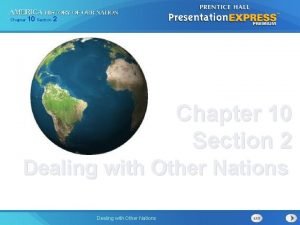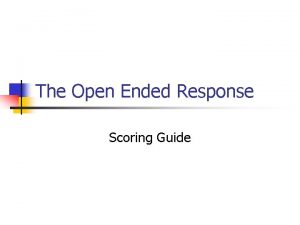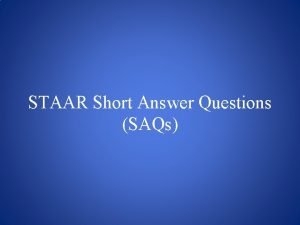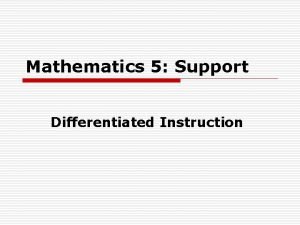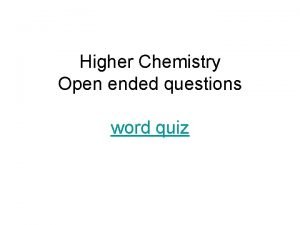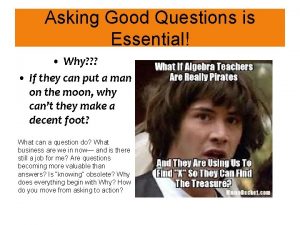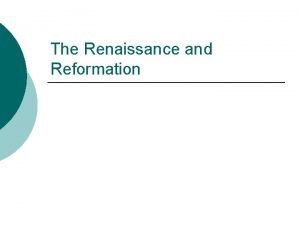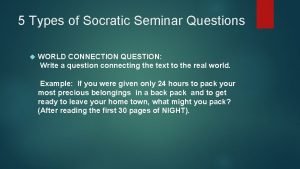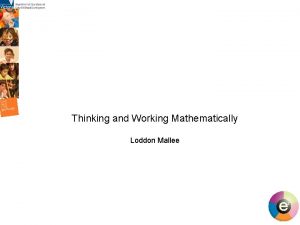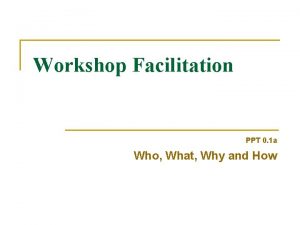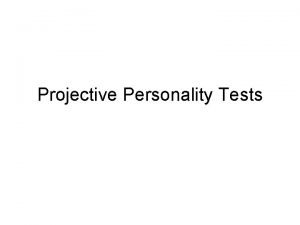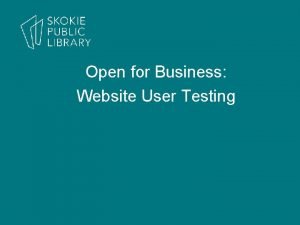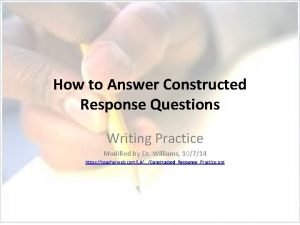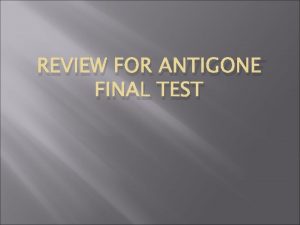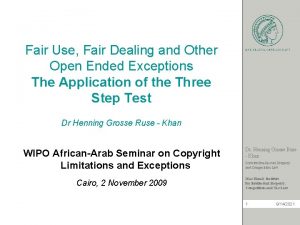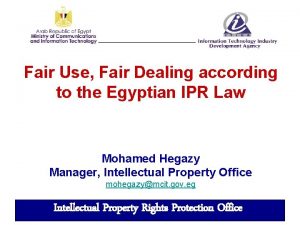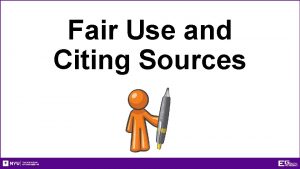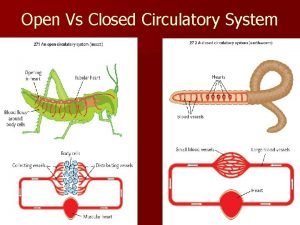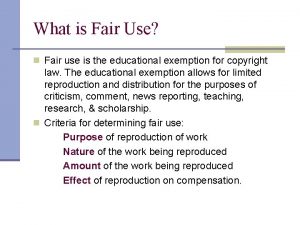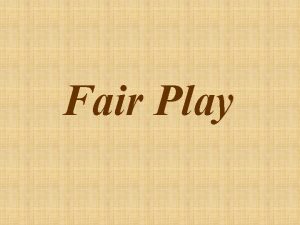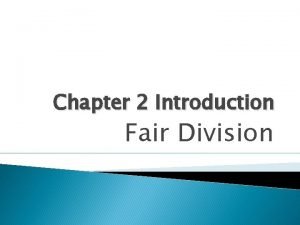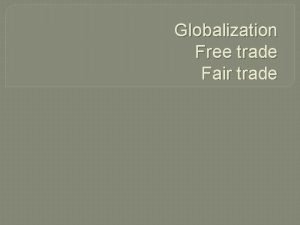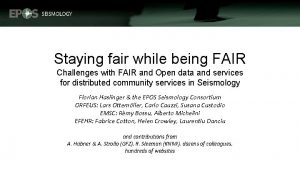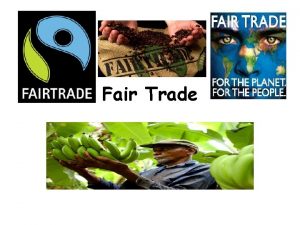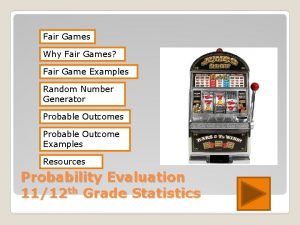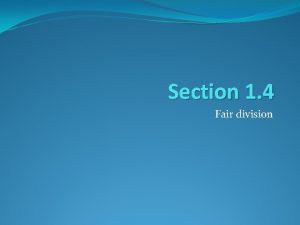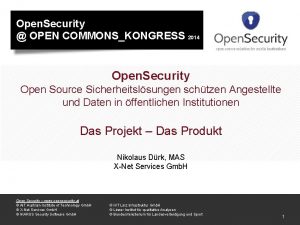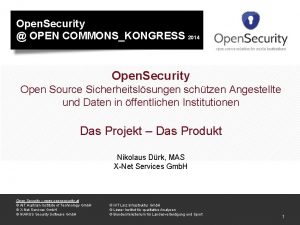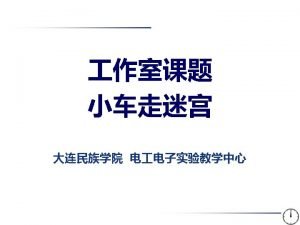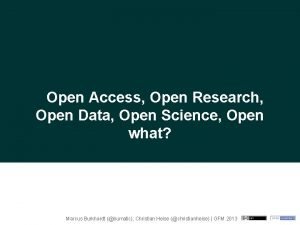Fair Use Fair Dealing and Other Open Ended






















- Slides: 22

Fair Use, Fair Dealing and Other Open Ended Exceptions The Application of the Three Step Test Dr Henning Grosse Ruse - Khan WIPO African-Arab Seminar on Copyright Limitations and Exceptions Cairo, 2 November 2009 Dr. Henning Grosse Ruse - Khan Division Intellectual Property and Competition Law Max Planck Institute for Intellectual Property, Competition and Tax Law 1 12/2/2020

Outline n The Concept of Fair Use and Fair Dealing Exceptions n The ‘Three Step Test’ as International Framework for National © Exceptions n An Obstacle for Domestic Policy Space to Adopt Tailored Exceptions? n A Flexible Interpretation of the Three Step Test: From Destructive to Constructive Ambiguity Dr. Henning Grosse Ruse - Khan Division Intellectual Property and Competition Law Max Planck Institute for Intellectual Property, Competition and Tax Law 2 12/2/2020

Open-Ended Exceptions: Fair Use and Fair Dealing Fair Use Doctrine, sec. 107 USCA n (…) the fair use of a copyrighted work, including such use by reproduction in copies or phonorecords or by any other means specified by that section, for purposes such as criticism, comment, news reporting, teaching (including multiple copies for classroom use), scholarship, or research, is not an infringement of copyright. n In determining whether the use made of a work in any particular case is a fair use the factors to be considered shall include (1) the purpose and character of the use, including whether such use is of a commercial nature or is for nonprofit educational purposes; (2) the nature of the copyrighted work; (3) the amount and substantiality of the portion used in relation to the copyrighted work as a whole; and (4) the effect of the use upon the potential market for or value of the copyrighted work. Dr. Henning Grosse Ruse - Khan Division Intellectual Property and Competition Law Max Planck Institute for Intellectual Property, Competition and Tax Law 3 12/2/2020

Open-Ended Exceptions: Fair Use and Fair Dealing Fair Use Examples: n Quotation of excerpts in a review or criticism for purposes of illustration or comment n Quotation of short passages in a scholarly or technical work, for illustration or clarification of the author’s observations n Use in a parody of some of the content of the work parodied n Summary of an address or article, with brief quotations, in a news report n Reproduction by a library of a portion of a work to replace part of a damaged copy n Reproduction by a teacher or student of a small part of a work to illustrate a lesson n reproduction of a work in legislative or judicial proceedings or reports Dr. Henning Grosse Ruse - Khan Division Intellectual Property and Competition Law Max Planck Institute for Intellectual Property, Competition and Tax Law 4 12/2/2020

Open-Ended Exceptions: Fair Use and Fair Dealing Main Characteristics: n Applicable to all exclusive rights, sec. 107 covers potentially all types of uses of © material for certain purposes n “Fair use” then depends on an overall assessment based on several factors “which though in no case definitive or determinative, provide some gauge for balancing the equities” (H. R. No. 94 -1476) Fair use is a broad and indeterminate exception which US courts have applied very differently on a case-by-case basis Dr. Henning Grosse Ruse - Khan Division Intellectual Property and Competition Law Max Planck Institute for Intellectual Property, Competition and Tax Law 5 12/2/2020

Open-Ended Exceptions: Fair Use and Fair Dealing, sec. 29, 30 CDPA n Fair dealing for the purposes of research (non-commercial) and private study, sec. 29 (1), (1 C) n Fair dealing for the purposes of criticism or review, sec. 30 (1) n Fair dealing for purposes of reporting current events, sec. 30 (2) n Generally, sufficient acknowledgement must be provided, sec. 29 (1), 30 (1), (2) n Often, exception does not apply to all categories works, sec. 29 (1), (1 C), 30 (2) Dr. Henning Grosse Ruse - Khan Division Intellectual Property and Competition Law Max Planck Institute for Intellectual Property, Competition and Tax Law 6 12/2/2020

Open-Ended Exceptions: Fair Use and Fair Dealing Criteria for ‘Fair’ Dealing: n Publication of the Work n Quantity / quality of amount taken (no disincentive to new creations) n Type of use (transformation, added value vs. commercial benefit) n Motive of user; consequences of dealing n Any less intrusive measures available? n Impact of human rights as strengthening public interests Need to weigh all factors based on the individual circumstances Dr. Henning Grosse Ruse - Khan Division Intellectual Property and Competition Law Max Planck Institute for Intellectual Property, Competition and Tax Law 7 12/2/2020

The ‘Three Step Test’ as International Framework The Three Step Test in Int. © Law: n Art. 9 (2) BC: It shall be a matter for legislation in the countries of the Union to permit the reproduction of such works in certain special cases, provided that such reproduction does not conflict with a normal exploitation of the work and does not unreasonably prejudice the legitimate interests of the author. n. Art. 13 TRIPS: Members shall confine limitations or exceptions to exclusive rights to certain special cases which do not conflict with a normal exploitation of the work and do not unreasonably prejudice the legitimate interests of the right holder. Dr. Henning Grosse Ruse - Khan Division Intellectual Property and Competition Law Max Planck Institute for Intellectual Property, Competition and Tax Law 8 12/2/2020

The ‘Three Step Test’ as International Framework The Three Step Test in Int. © Law: Art. 10 WCT (1) Contracting Parties may, in their national legislation, provide for limitations of or exceptions to the rights granted to authors of literary and artistic works under this Treaty in certain special cases that do not conflict with a normal exploitation of the work and do not unreasonably prejudice the legitimate interests of the author. (2) Contracting Parties shall, when applying the Berne Convention, confine any limitations of or exceptions to rights provided for therein to certain special cases that do not conflict with a normal exploitation of the work and do not unreasonably prejudice the legitimate interests of the author. Dr. Henning Grosse Ruse - Khan Division Intellectual Property and Competition Law Max Planck Institute for Intellectual Property, Competition and Tax Law 9 12/2/2020

The ‘Three Step Test’ as International Framework Role & Function of the Three Step Test n By establishing 3 general conditions for enacting © exceptions in national laws, the 3 step test regulates the national autonomy to prescribe exceptions to © n Other © exceptions in BC are lex specialis, with the 3 step test as outer limit (Art. 10 (2) WCT) without changing their scope… n Model character for other TRIPS rules on exceptions on patent, TM, & Design rights horizontal int. rule on national exceptions to IPRs Dr. Henning Grosse Ruse - Khan Division Intellectual Property and Competition Law Max Planck Institute for Intellectual Property, Competition and Tax Law 10 12/2/2020

An Obstacle for Domestic Policy Space Interpretation by WTO Panels (I) In June 2000, a WTO Panel found a specific exception in US © inconsistent with Art. 13 TRIPS: n Art. 13 applies to exclusive rights of BC, TRIPS n certain special cases: Clearly defined and narrow in scope and reach n a normal exploitation: any current & potential (certain degree of likelihood) market n conflict: “uses [which] enter into economic competition with the ways that right holders normally extract economic value from that exclusive right to the work and thereby deprive them of significant or tangible commercial gains” Dr. Henning Grosse Ruse - Khan Division Intellectual Property and Competition Law Max Planck Institute for Intellectual Property, Competition and Tax Law 11 12/2/2020

An Obstacle for Domestic Policy Space Interpretation by WTO Panels (II) n unreasonable prejudice of legitimate interests: l Legitimate interests of right holders are primarily defined by the “economic value of the exclusive rights“ (estimation by reference to market value of a license) l “[P]rejudice to the legitimate interests of right holders reaches an unreasonable level if an exception or limitation causes or has the potential to cause an unreasonable loss of income to the copyright owner. “ l National exceptions that do result in “serious loss of profit for the copyright owner” can still survive the 3 step test by providing the owner “with some compensation (a system of compulsory licensing with equitable remuneration)” Public interest motives behind nat. exceptions cannot prevail over interests of right holders Dr. Henning Grosse Ruse - Khan Division Intellectual Property and Competition Law Max Planck Institute for Intellectual Property, Competition and Tax Law 12 12/2/2020

An Obstacle for Domestic Policy Space Impact on Open-ended Exceptions n Certain special cases vs. broad scope and indeterminate application (e. g. US fair use), ‘fairness’ as key factor (UK fair dealing) n No conflict with a normal exploitation vs. US case law which sometimes does allow a negative impact on actual/potential market if e. g. the use is highly transformative (see US Sup. Ct. in Campbell vs Acuff Rose, 510 U. S. 569 (1994)) n No unreasonable prejudice to legitimate interests? Case-specific (proportionality? ) analysis under fair use and fair dealing Dr. Henning Grosse Ruse - Khan Division Intellectual Property and Competition Law Max Planck Institute for Intellectual Property, Competition and Tax Law 13 12/2/2020

An Obstacle for Domestic Policy Space Potential Impact on DCs: n Regulatory freeze: Especially countries without a history of © legislation and existing © exceptions might refrain from introducing tailored exceptions in fear of acting inconsistent with the 3 step test n Exceptions cannot be drafted from the perspective to give effect to public interest measures, (e. g. A 2 K via exceptions for research, education) n Consistency of any future treaty on © exceptions (WBU proposal) with 3 step test? Dr. Henning Grosse Ruse - Khan Division Intellectual Property and Competition Law Max Planck Institute for Intellectual Property, Competition and Tax Law 14 12/2/2020

Achieving Constructive Ambiguity via a Flexible Interpretation Objectives in Treaty Interpretation (I) n Art. 31: 1 VCLT: “A treaty shall be interpreted in good faith in accordance with the ordinary meaning to be given to the terms of the treaty in their context and in the light of its object and purpose. ” n Art. 7 TRIPS: IP protection “should contribute to the promotion of technological innovation and to the transfer and dissemination of technology, to the mutual advantage of producers and users of technological knowledge and in a manner conducive to social and economic welfare, and to a balance of rights and obligations. ” n Para. 5 a) Doha Decl. : “(…) each provision of the TRIPS Agreement shall be read in the light of the object and purpose of the Agreement as expressed, in particular, in its objectives and principles. ” Dr. Henning Grosse Ruse - Khan Division Intellectual Property and Competition Law Max Planck Institute for Intellectual Property, Competition and Tax Law 15 12/2/2020

Achieving Constructive Ambiguity via a Flexible Interpretation Objectives in Treaty Interpretation (II) n WCT Preamble: “Recognizing the need to maintain a balance between the rights of authors and the larger public interest, particularly education, research and access to information, as reflected in the Berne Convention” n BC Preamble: “The countries of the Union, being equally animated by the desire to protect, in as effective and uniform a manner as possible, the rights of authors in their literary and artistic works” n Art. 20 BC, Art. 2: 2 TRIPS, Art. 1 WCT: Overriding the more balanced interpretation mandated by TRIPS, WCT? Dr. Henning Grosse Ruse - Khan Division Intellectual Property and Competition Law Max Planck Institute for Intellectual Property, Competition and Tax Law 16 12/2/2020

Achieving Constructive Ambiguity via a Flexible Interpretation Translating Open Treaty Terms into Domestic Policy Space: n With due regard to ordinary meaning and context, the role of TRIPS, WCT balancing objectives will be decisive for broad and open treaty terms n As treaty interpretation and implementation is to be performed primarily by states, giving effect to the balancing objectives translates into domestic policy space how to balance n Int. Courts must respect this balance – if within the boundaries of Art. 31 VCLT Dr. Henning Grosse Ruse - Khan Division Intellectual Property and Competition Law Max Planck Institute for Intellectual Property, Competition and Tax Law 17 12/2/2020

Achieving Constructive Ambiguity via a Flexible Interpretation Agreed Statements to Art. 10 WCT n It is understood that the provisions of Article 10 permit Contracting Parties to carry forward and appropriately extend into the digital environment limitations and exceptions in their national laws which have been considered acceptable under the Berne Convention. n Similarly, these provisions should be understood to permit Contracting Parties to devise new exceptions and limitations that are appropriate in the digital network environment. n It is also understood that Article 10(2) neither reduces nor extends the scope of applicability of the limitations and exceptions permitted by the Berne Convention. n interpretative role? Relevant context for WCT (Art. 31 (2) a) VCLT); but for BC (Art. 31 (3) a), c) VCLT)? Dr. Henning Grosse Ruse - Khan Division Intellectual Property and Competition Law Max Planck Institute for Intellectual Property, Competition and Tax Law 18 12/2/2020

Achieving Constructive Ambiguity via a Flexible Interpretation Declaration on the Three Step Test (I) n “(…) historic evidence, economic theory and the principle of self determination suggest that individual states should have sufficient flexibility to shape copyright law to their own cultural, social and economic development needs. Copyright exceptions and limitations tailored to domestic needs provide the most important legal mechanism for the achievement of an appropriate, self-determined balance of interests at national level. ” n “International economic regulation allows for a balance of economic and social interests. International intellectual property law also stresses the need for balance. In the field of copyright law, this Declaration proposes an appropriately balanced interpretation of the Three-Step Test under which existing exceptions and limitations within domestic law are not unduly restricted and the introduction of appropriately balanced exceptions and limitations is not precluded. ” Dr. Henning Grosse Ruse - Khan Division Intellectual Property and Competition Law Max Planck Institute for Intellectual Property, Competition and Tax Law 19 12/2/2020

Achieving Constructive Ambiguity via a Flexible Interpretation Declaration on the Three Step Test (II) n The Three-Step Test does not require limitations and exceptions to be interpreted narrowly. They are to be interpreted according to their objectives and purposes. n The Three-Step Test’s restriction of limitations and exceptions to exclusive rights to certain special cases does not prevent (…) legislatures from introducing open ended limitations and exceptions, so long as the scope of such limitations and exceptions is reasonably foreseeable (…) n Limitations and exceptions do not conflict with a normal exploitation of protected subject matter, if they are based on important competing considerations (…) n The Three-Step Test should be interpreted in a manner that respects (…) interests deriving from human rights and fundamental freedoms, (…) other public interests, notably in scientific progress and cultural, social, or economic development Dr. Henning Grosse Ruse - Khan Division Intellectual Property and Competition Law Max Planck Institute for Intellectual Property, Competition and Tax Law 20 12/2/2020

Achieving Constructive Ambiguity via a Flexible Interpretation Constructive Ambiguity in the 3 step test: n ‘Special’ cases may include those which address public interests recognised inter alia in Art. 7 or Art. 8: 1 TRIPS n Exploitation could be considered ‘normal’ only if it does not significantly interfere with such interests n ‘legitimate’ interests of right holders may only be those which sufficiently reconcile the public interests recognised in the WTO/TRIPS objectives n Any ‘prejudice’ which is caused by good faith measures (necessary for) protecting those interests may be understood as not being ‘unreasonable’ Countries should aim to utilise the policy space inherent in the test’s open terms Dr. Henning Grosse Ruse - Khan Division Intellectual Property and Competition Law Max Planck Institute for Intellectual Property, Competition and Tax Law 21 12/2/2020

Thank you for your attention! Any comments and critique to henning. gr-khan@ip. mpg. de Dr. Henning Grosse Ruse - Khan Division Intellectual Property and Competition Law Max Planck Institute for Intellectual Property, Competition and Tax Law 22 12/2/2020
 Reggio emilia toys
Reggio emilia toys 3p fair dealing
3p fair dealing Section 2 dealing with other nations
Section 2 dealing with other nations Characteristics of open ended questions
Characteristics of open ended questions Short answer response staar
Short answer response staar Contoh open ended question adalah
Contoh open ended question adalah Open ended questions examples
Open ended questions examples Open ended questionnaire example
Open ended questionnaire example Higher chemistry open ended questions with answers
Higher chemistry open ended questions with answers What makes a question essential
What makes a question essential Renaissance discussion questions
Renaissance discussion questions The cask of amontillado discussion questions and answers
The cask of amontillado discussion questions and answers Open ended questions social work
Open ended questions social work Themes of animal farm with quotes
Themes of animal farm with quotes Oedipus rex discussion questions
Oedipus rex discussion questions Open ended questions for counseling
Open ended questions for counseling World connection questions examples
World connection questions examples Open ended maths activities peter sullivan pdf
Open ended maths activities peter sullivan pdf Virtual facilitation skills ppt
Virtual facilitation skills ppt Projective open ended story test
Projective open ended story test Close ended question
Close ended question What is a constructed response question
What is a constructed response question What is choragos final advice
What is choragos final advice


